CRUISING THE RHINE AND MOSEL RIVERS – IN THE LAND OF THE WINDMILLS
CRUISING THE RHINE AND MOSEL RIVERS
This is the 12th in a series of articles about cruising the Rhine and Mosel rivers
IN THE LAND OF THE WINDMILLS
By Charles N. Stevens
Photos by Dolores Seidman
The morning is still dark when wake up. I peer out at a green navigation light and the twinkling lights of a great oil refinery that resembles a bustling city. Then the day dawns in a clear sky with only a single brush stroke of wispy clouds. The silhouette of a loading crane spreads out against the sky, another indication that we’re now in an industrial section of the river. Just before eight we dock at Kinderdijk, the pink of dawn contrasting with the silver blue of the river.
After breakfast, we begin a walking tour that will take us to a row of old windmills built in 1740, once used to pump water from the canals. Originally there were 19 of these all along the canal. A brisk wind ruffles the tall grasses along the canal as we walk toward the windmills. Coots cruise in the canal among the reeds. Our first sight of all those windmills takes our breaths away. The sails of one turn round and round in the stiff wind. As we approach it we get a sense of its power, the huge arms whirling at great speed, their swishing sound as each one turns by us.
We are able to walk inside the active mill, the interior space not only housing the rumbling inner workings but also plenty of room for living quarters. Some of our group climbed perilous looking stairs to get a better look at the active gears and mechanism, but prudently we stayed on the first floor. We learned that people can rent and live in the windmills much like they would rent a house. They have to agree to maintain them and allow the arms to turn periodically for several hours. Today the windmill’s function has been superseded by huge Archimedes screws run by electrical power that can pump the water far more efficiently.
We ride back to our starting point in a small covered boat, then Dolores and I are free to walk around in the town of Kinderdijk. Just as we start our walk, a flock of geese flies over, heading south. Ambling around in a residential area is very relaxing and reminds us of former trips to the Netherlands when we also enjoyed walks in small towns. It was nice to see lace curtains hanging in crystal clear windows, usually flowers or ceramics also on display. Many of the houses had gardens in back. One house had ceramic Dutch shoes affixed to the outside wall near a door. A cool wind blew through some of the streets, and sometimes we were afforded a view of swaying feather grasses along the canal and a windmill or two in the distance–an authentic Dutch experience.
Now back on the boat, we cruise the river again. We pass the Rotterdam area with its heavy industry, smoke stacks, ocean-going ships and fleets of barges. By afternoon we arrive in Willemstad, the most imposing sight being a windmill perched on a rise, its blades inactive. The river being wide enough here, sailboats glide in and out of the marina, having plenty of room for sailing.
We begin the walking tour near the ramparts of the old town, leftovers from the time when they were protecting themselves from the attacking Spanish. Since the Dutch had increasingly turned to Protestantism, the Catholic Spanish were trying to reinstate Catholicism. We walk by the brick arsenal built in 1783 then past the marina where the cables of sailboats tinkle against their metal masts like a multitude of wind chimes. Nearby is the windmill we saw earlier, one that was once used to grind wheat into flour.
Moving on, Dolores and I walk down a gentle slope to a row of houses, curiously with a small moat in front of them. The water in it didn’t seem to move, and much of its surface was covered with duckweed and even water lilies. At a bakery, a man offers us a sample of Dutch cake– very good. In our return toward town, we walk along a street with many linden trees, their leaves just beginning to turn autumn yellow. A contented cat lounges in the window of one house, accompanied by classic vases. We come upon a Dutch Reformed Church, this denomination being the first Protestant churches built in Holland, a moat still surrounding it. Nearby is the residence of the prince, called Princhof, also guarded with a moat. During World War II it was used as a hospital. I don’t know whether the prince still uses it. A man greets us from his second story window of a large white house as we walk by, a friendly gesture.
Our walk ends at the bastions mentioned earlier, the Bastion Gelderland. We paused at former bunkers and old artillery emplacements, paths leading from one to the other. From here we had a nice view of the picturesque town and the water. A refreshing cool breeze blew over the ramparts, a great place to end our touring for the day.
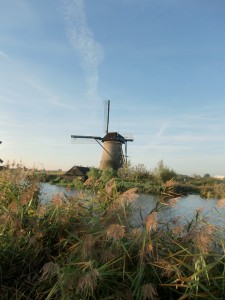
This wonderful scene of Dutch windmills at Kinderdijk nearly took our breath away.
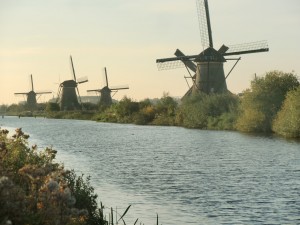
The canal at Kinderdijk with its reeds and tall grasses plus the lone windmill and a refreshing breeze made this scene ideal.
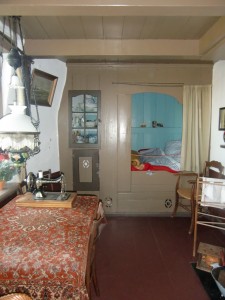
People actually live inside the windmills. One can rent a windmill to occupy, first agreeing to maintain it.
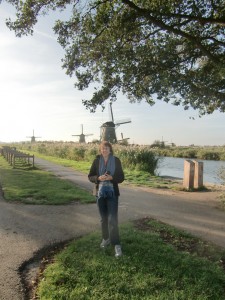
Dolores poses with the idyllic windmill scene behind her.
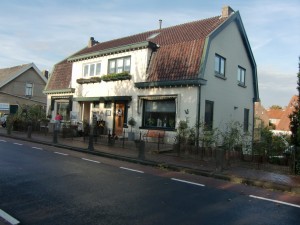
This Dutch house with its sparkling clean windows and lace curtains is typical in Kinderdijk and all of The Netherlands.
MONTEREY PARK AUTHOR PUBLISHES 3RD BOOK ABOUT HIS EXPERIENCES IN WORLD WAR II- BACK FROM COMBAT
Charles “Norm” Stevens, a 40 year resident of Monterey Park and World War II Veteran has recently published the 3rd in his series about his experiences in WW II, Back from Combat: A WWII Bombardier Faces His Military Future. This book details the time from when he returned from combat in England where he flew 34 missions over Germany and France until the end of the war. Faced with large numbers of returning combat vets, and not knowing how long the war would continue, the military had to plan for their future. His options were whether to return to combat, become an instructor in the U.S., or receive new training that he would use in the Pacific. The book concludes with the end of the war with an Afterward that includes an update on the B-l7’s still flying in the U.S., as well as present day accounts pertaining to the war.
Stevens is the author of two previous books about his experiences:
An Innocent at Polebrook: A Memoir of an 8th Air Force Bombardier (Story of his 34 bombing missions from his base at Polebrook, England over Germany and France)
The Innocent Cadet: Becoming A World War II Bombardier (A prequel to the first, telling of his training in the U.S. before going overseas into combat.)
He is known to the readers of The Citizen’s Voice as the author of Travel Log Articles including “From Paris to Normandy on the Seine”, “Exploring New York” and “In Search of Snow.” He is retired, having taught for 32 years, primarily in the Montebello Unified School District.
Those interested in purchasing an autographed copy of any of his books, may contact the author at 323-721-8230 or Normstevens24@gmail.com.



